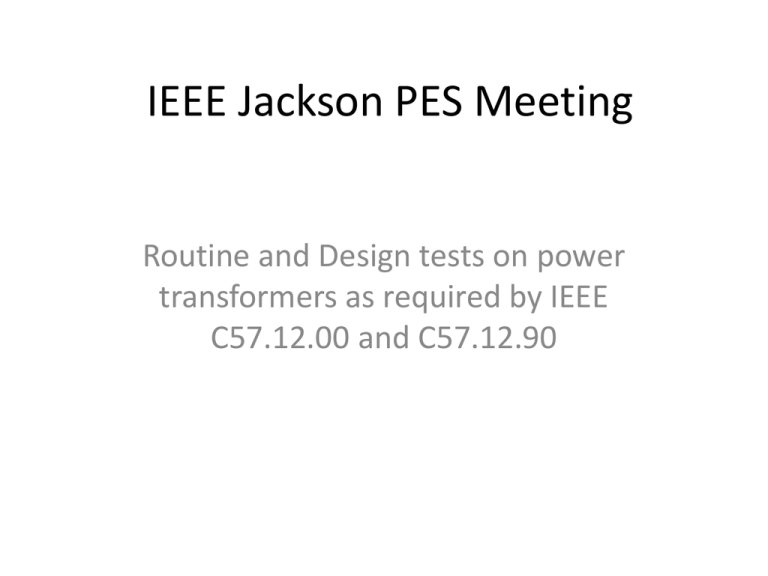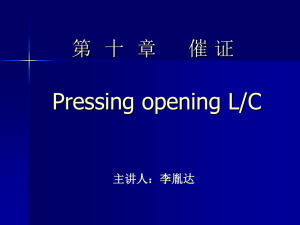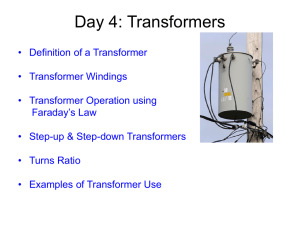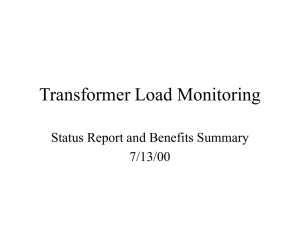IEEE Jackson PES Meeting
advertisement

IEEE Jackson PES Meeting Routine and Design tests on power transformers as required by IEEE C57.12.00 and C57.12.90 C57.12.00 IEEE Standard for General Requirements for Liquid-Immersed Distribution, Power and Regulating Transformers Service Conditions Rating Data Construction Short Circuit Testing and Calculations Tolerances Connections for shipment Annex for Front of Wave (Informative) C57.12.90 IEEE Standard Test Code for LiquidImmersed Distribution, Power and Regulating Transformers Resistance Measurements Ratio tests Load Loss and impedance Temperature rise tests Audible sound level Annex A Partial Discharge Polarity and Phase relation No-load loss and excitation Di-electric tests Short circuit tests Calculated Data Annex B Frequency conversion Routine and Design tests • Routine tests shall be made on every transformer to verify that the product meets the design specifications. • Design tests shall be made on a transformer of new design to determine the adequacy of the design of a particular type, style or model of transformer or its component parts. • Other tests are identified in individual product standards and may be specified by the purchaser in addition to routine tests. Insulation levels • Class I power transformers shall include power transformers with high-voltage windings of 69kV and below. • Class II power transformers shall include power transformers with high-voltage windings from 115kV thru 765kV. Routine, design and other tests for transformers Tests Type Resistance measurements of all windings on the rated voltage tap and at the tap extremes Routine Explanation of the test To verify that the measured winding resistance is within 3% of the calculated winding resistance, and that all internal connections and welds were performed properly Winding Insulation Resistance Routine for Class-II To measure the quality and dryness of the , Other for Class-I transformer insulation system Core Insulation Resistance Routine for Class-II To verify that no unintentional grounds are , Other for Class-I present on the transformer core Ratio, polarity and phase relation tests on the rated voltage connection and on all tap connections Insulation Power Factor and capacitance Control (auxiliary) cooling losses Low frequency test on auxiliary devices and current transformers Single Phase Excitation tests on the rated voltage connection. Routine To verify that all windings have the correct number of turns and all winding leads are properly connected and the correct phase rotation is achieved. To verify the quality of the transformer Routine for Class-II insulation system. , Other for Class-I Other To measure the losses drawn by the fans and other auxiliary devices during operation Other for Class I, To verify the dielectric integrity of the Routine for Class II auxiliary devices, wiring and CTs Other To verify that the core design and its performance is satisfactory, and that no failures are located in the winding insulation system Routine, design and other tests for transformers Tests No-Load Losses and exciting current at 100% and 110% of rated voltage and at rated power frequency and on the rated voltage tap connections Impedance voltage and load loss at rated current and rated frequency on the rated voltage connection and at the tap extremes. Zero Phase Sequence impedance voltage Temperature Rise Test -At minimum and maximum ratings of the first unit of a new design - At minimum and maximum ratings when temperature rise tests are specified. - Special ratings per customer specs Low frequency di-electric test (Applied Potential test) Type Explanation of the test Routine To verify that the core was designed and manufactured to meet the calculated/guaranteed core loss value Routine To verify that the windings and active part were designed and manufactured to meet the calculated/guaranteed load loss and percent impedance values Design for Class I, Routine for Class II To verify that the active parts with windings were designed and manufactured to the calculated/guaranteed zero phase sequence impedance value Design Other-Other Other-Other Routine The Temperature Rise Test verifies that the thermal performance of the transformer cooling system is designed and manufactured to meet the calculated and guaranteed values To verify that the insulation between the windings and the windings to ground is adequate, including lead clearances Routine, design and other tests for transformers Tests Lighting Impulse Test Switching impulse, phase-to-ground Partial Discharge and Radio Interference test Audible Sound Level Test Dissolved gases in oil analysis CT Ratio and Polarity Type Explanation of the test Design& Other for Class I, Routine for Class II Other for both but Routine for 345kV and above To verify the insulation class to withstand the guaranteed basic insulation level (BIL) To verify the insulation integrity of the transformer for switching stress in the field. To verify the integrity of the transformer insulation system to meet the guaranteed level of apparent charges occur within the transformer. Routine for Class-II Other for Class-I Design for first unit and other Routine for Class-II Other for Class-I Routine CT Insulation Resistance Routine Operational test of all devices Routine Single phase impedance test Other Sweep Frequency response Analysis test Other To verify that the sound generated by the transformer does not exceed the guaranteed maximum decibel level during operation. To verify that the transformer had no combustible gas generation during various types of tests To verify that all current transformers are connected and polarity is correct To verify that all the secondary leads of the current transformers have adequate insulation to ground all the way to the control cabinet To verify all the control wiring is correct and the auxiliary devices are operational. To measure the impedance value of each set of windings separately To measure the response of each phase under different frequencies. This test is to verify any coil movement between different times of testing.







